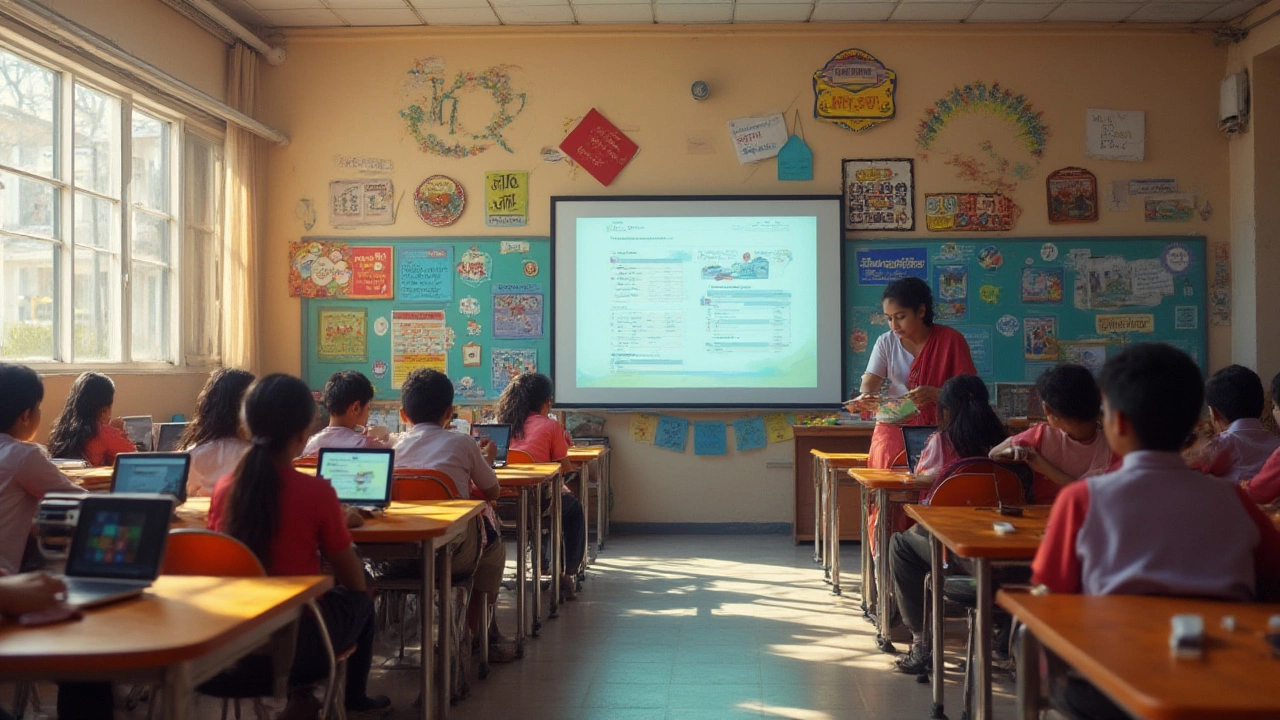
Keen-eyed students and parents have started noticing something odd—fewer sticky notes with Google Meet codes, hardly any frantic searches for a lost Doc link, and teachers who don’t sigh, “Try reloading Google Drive.” After years when Google was everywhere in classrooms, from Chromebooks to Google Classroom, a swelling number of schools are quietly opting out. Some say it's about privacy; others complain about new fees or interfaces that make life trickier instead of easier. So, what’s really going on behind the closed doors of school IT departments?
How Google Became the Classroom Standard—and Why That’s Changing
Just a handful of years back, Google was the undisputed king of the school day. Google Classroom, Docs, and Drive powered group activities, digital assignments, and presentations. They were free, easy, and synced with cheap Chromebooks—at least, that’s how things used to feel. The pandemic shot Google’s dominance into another league. In 2020, Google reported more than 150 million students and educators globally using its education tools. Here in Australia, even tiny rural schools leaned heavily on Google’s cloud, with some states bulk-buying Chromebooks to keep digital learning flowing.
Yet, cracks began to show. By late 2023, headlines about student data being collected without clear parental consent stirred up debates. European countries like the Netherlands and Germany clamped down on Google’s data handling, calling it non-compliant with strict EU privacy laws (GDPR). Dutch schools pressed pause and looked for alternatives, worried about storing student essays and personal data on US servers. In the US, some districts grew jittery over Google’s ad business and whether student activity was feeding the company’s algorithms, despite Google’s long-standing “no advertising in education” pledge. Lawsuits alleging privacy breaches signaled that things weren’t as clear-cut as they once seemed.
And then Google started making changes—restructuring its longtime free suite for schools, introducing extra paid features, and quietly nudging administrators toward “premium” plans if they wanted storage or new functions. For cash-strapped schools in regional Australia or inner-city India, these new charges forced a rethink: Why stick with Google if it meant paying for what used to be free?
That’s not all. Teachers also began grumbling about updates that broke favorite features or made things more complicated. If kids can’t always connect, and teachers can’t figure out where files go, the whole promise of cloud learning suddenly looks shaky. So while most families still think “Google” when they think “online school,” school boards and IT staff are eyeing other options, quietly trialing new apps and returning Chromebooks at the end of their leases.
The Privacy Puzzle: Parental Concerns and Legal Cracks
Talk to any school IT admin in 2025, and privacy pops up fast. Today’s parents aren’t just worried about their kids seeing scary YouTube videos—they’re worried about who’s reading their kids’ emails, what location data is being stored, and whether a simple spelling assignment is really secure. In 2024, a high-profile incident in Victoria saw parents object when a school’s updates to Google’s Terms of Service triggered new data-sharing agreements with a US-based parent company. An uproar followed, with local news stories and tense parent-teacher meetings. The school eventually paused Google Classroom for a term while they figured things out.
Across the globe, Europe’s GDPR has been the main driver of Google’s woes. Dutch, Danish, and German authorities released reports listing the ‘blind spots’ in Google’s contracts—like vague language about data analytics and ambiguous controls for schools. They pushed to keep all student records inside national borders—no easy feat for a platform with US servers everywhere. In October 2024, Norway became the latest to restrict Google’s school apps, citing “insufficient control over student personal data.”
Australia’s privacy rules aren’t as strict, but watchdogs have started nudging school admins to double-check how student information is stored. The Office of the Australian Information Commissioner published a guidance note in 2024 warning that “cloud-based classroom platforms must support transparency and parental notice.” Some states responded with their own vetted list of approved platforms that exclude Google by default. For rural schools that leaned on Google Meet for remote learning, this felt like pulling the rug out during an online math test.
It’s not just legal threats. Some teachers worry about accidental data leaks—say, a class list or student marks sent to the wrong address in Gmail. In one Sydney school, a teacher’s account malfunctioned, sending private feedback for a student’s report card to an entire year group instead of just the family. These small mistakes add up to real stress, and when parents get letters about a new “data policy,” trust can fray fast.

New Tech on the Block: What’s Replacing Google?
If not Google, what are schools using now? There’s no single answer—schools aren’t all marching to the same drum. Some swap Google for Microsoft 365, liking its tight privacy settings and familiar interfaces. Others test out Canvas, Moodle, or open-source solutions that can keep all files on local servers. Older students get to grips with Slack for group projects, Notion for digital portfolios, and Zoom for online lessons.
Let’s look at a quick rundown of popular alternatives that schools in Melbourne and beyond are rolling out:
- Microsoft 365 Education: Packs in Teams, Word, and OneDrive. Victorian schools can route student data through Australian servers, pleasing privacy watchdogs. Teachers say Teams plays nice with existing IT setups and support is easy to get.
- Canvas and Moodle: These learning management systems allow for plug-and-play customization. The big edge is local hosting, so all student work stays in-country. Open-source options mean lower costs for tech-savvy schools.
- Zoom and Webex: Lean, easy, and with fewer storage headaches. Some school districts choose these just for virtual classes, skipping the whole “cloud drive” headache for the bulk of student work.
- Specialist apps: Flipgrid for quick video assignments, Book Creator for primary kids, and Notion for digital note-taking in high school.
Switching isn’t always simple, though. It can take weeks to retrain staff and port old files. In 2025, schools share lessons in Facebook groups: “Double-check that Teams settings so students can’t DM each other after hours,” or “Canvas can break links in older Docs—here’s a fix.” Professional development day is spent just learning the new menu layouts.
The verdict? No single replacement is as smooth as the all-in-one Google suite. Instead, schools cobble together what fits, weighing privacy, features, and affordability. Some even rotate tools—using Zoom for remote parent-teacher nights and MS Teams for in-class communication. A few, especially smaller schools, return to paper in places they used to be proudly ‘all digital.’ It’s less flashy, but sometimes, less is more.
The Future of Digital Classrooms: Adaptation or Reinvention?
So, what does ditching Google actually look like in a busy classroom? It’s not just about swapping apps. Teachers juggle more passwords, IT staff brace for extra “help!” emails, and students get a crash course in file conversions. But there’s a silver lining: some learning becomes more intentional and less app-driven. Without the ‘Google default’, teachers pick tools based on what’s best for their lesson, not just what’s easiest to click.
Curious about the scale of the shift? Here’s a breakdown of 2024-2025 data from IT administrators in Oceania and Europe:
| Region | Google Usage in Schools (%) | Microsoft 365 Usage (%) | Others (Canvas, Moodle, etc.) |
|---|---|---|---|
| Australia (Victoria) | 53 | 41 | 6 |
| Germany | 19 | 67 | 14 |
| Netherlands | 10 | 75 | 15 |
| USA (Urban) | 62 | 24 | 14 |
The numbers show a clear drop in Google usage throughout Europe—where privacy laws are strictest. Here in Australia, the numbers haven’t cratered, but every year, a few more classrooms log out for good.
If you’re a parent or teacher, what should you do? Start by asking your school how student info is stored and what happens if a digital tool has a breach. Don’t be afraid to push for transparency—privacy isn’t just for lawyers. And take time to explore new platforms with your kids; today’s homework might be on Teams, Canvas, or even handwritten.
Maybe in a few years, we’ll look back and laugh at the wild early days of “Google everything.” My dog Leo, who sometimes stares at the flashing screens while I work from home, would approve of a day with fewer tabs open. Either way, the classroom of 2025 looks a lot less like Big Tech’s playground—and a bit more like a collection of tailor-made toolkits, picked by the people who know students best.
